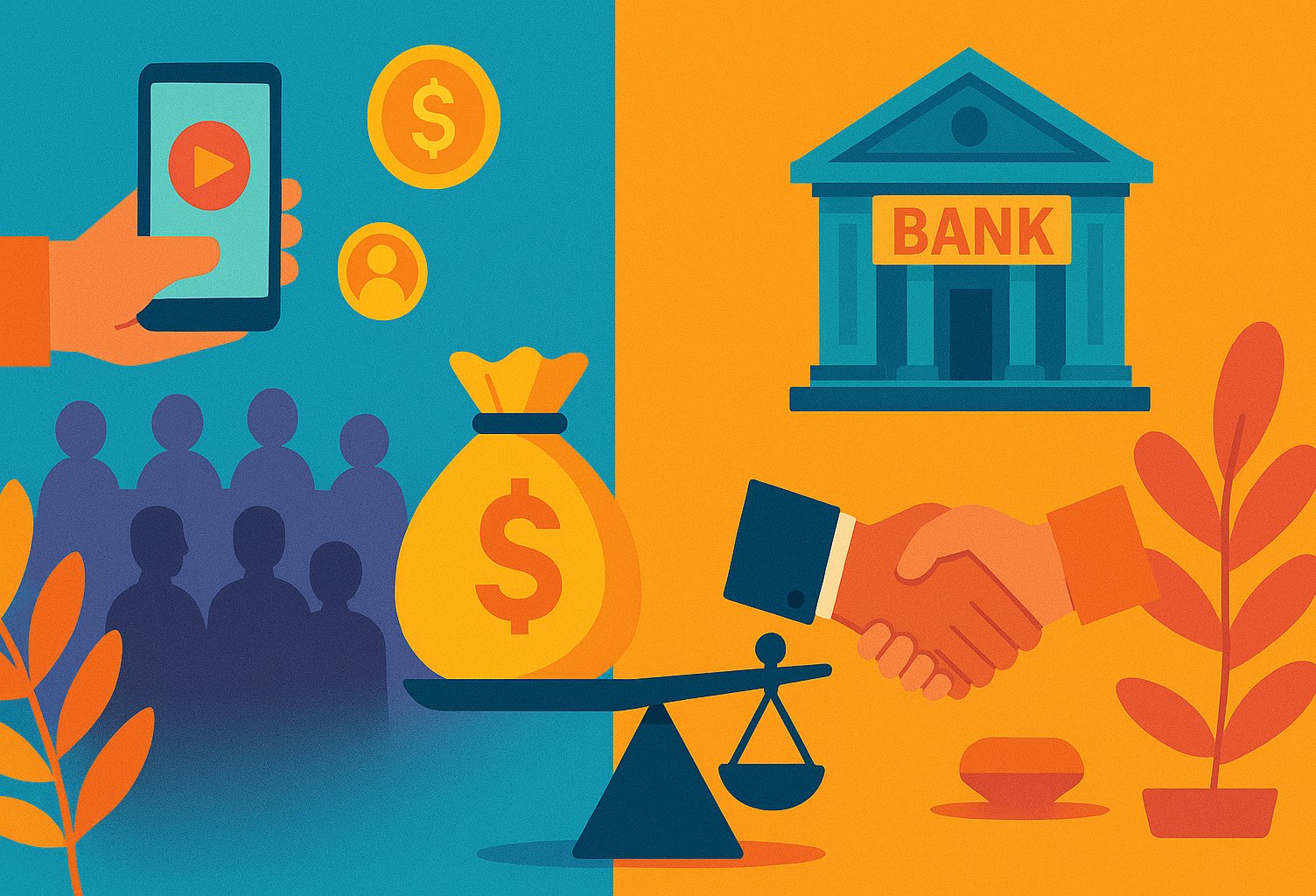Pioneering Paths: Navigating Crowdfunding and Bank Loans
In today’s entrepreneurial ecosystem, raising capital has evolved into an art as much as a science. Entrepreneurs no longer face a one-size-fits-all decision; instead, they stand at a crossroads where digital communities and traditional institutions both beckon. Crowdfunding—once the domain of indie filmmakers and gadget enthusiasts—has matured into a mainstream channel, empowering founders to tap hundreds or thousands of micro-investors with nothing more than a compelling narrative and polished campaign page. At the same time, bank loans remain a steadfast pillar of finance, offering predictable repayment schedules, established credibility, and non-dilutive capital for businesses with strong credit profiles and tangible collateral.
Choosing between these paths hinges on balancing emotion-driven community engagement against regimented financial stewardship. Crowdfunding transforms backers into brand evangelists, inspiring viral buzz and authentic market validation, but it demands meticulous campaign strategy and flawless fulfillment planning. Bank loans deliver reliable funding without diluting ownership, yet they impose strict covenants, interest payments, and the scrutiny of underwriters. In the sections that follow, we’ll embark on a deep dive into both worlds, unveiling their unique advantages, hidden hurdles, and the strategic insights you need to chart a financing course that aligns with your vision, risk appetite, and growth ambitions.
Democratizing Dreams: The Crowdfunding Phenomenon
Crowdfunding has redefined fundraising by opening the gates to anyone with an internet connection. Platforms such as Kickstarter and Indiegogo invite entrepreneurs to present a polished pitch—complete with videos, prototype images, and tiered rewards—to a global audience primed for discovery. This model thrives on authenticity: backers pledge because they resonate with the founder’s story, believe in the product’s promise, or simply want to be part of something groundbreaking. When a campaign catches fire, social media shares and press coverage can amplify momentum exponentially, turning grassroots enthusiasm into tangible dollars. Beyond the capital infusion, crowdfunding offers a direct line to customer feedback, enabling iterative improvements before large-scale production begins.
The Pillars of Capital: Unpacking Bank Loans
Bank loans have long served as the financial backbone for small and medium-sized businesses. Underwriters evaluate credit scores, collateral values, and cash flow projections to determine eligibility, interest rates, and repayment terms. Upon approval, borrowers receive lump-sum disbursements or access to revolving lines of credit, which can fund inventory purchases, facility expansions, or working capital needs. Unlike equity financing, loans do not require giving up ownership stakes or board representation, preserving founders’ creative and operational control. However, the structured nature of bank lending means that failure to meet repayment schedules can damage credit histories and trigger collateral forfeitures. For ventures with proven revenue models and tangible assets, bank loans remain a dependable source of growth capital.
Crossroads of Capital: Contrasting Crowdfunding and Loans
At their core, crowdfunding and bank loans share a mutual goal—to fuel business ventures—yet their mechanisms diverge sharply. Crowdfunding leverages narrative and community, relying on a compelling story and strategic digital marketing to attract myriad small pledges. Bank loans hinge on quantitative metrics: creditworthiness, asset valuation, and debt-service coverage. Crowdfunding funds are unlocked only after successful campaigns, often within a 30- to 60-day window, whereas loan disbursement timelines can stretch over several weeks of due diligence. Equity dilution is absent in loan agreements, but repayment obligations are inflexible. Conversely, successful crowdfunding preserves equity but may fall short for capital-intensive projects. Recognizing these fundamental contrasts is vital to selecting the financing avenue that best matches your operational style and funding needs.
Crowdfunding’s Crescendo: Unveiling Its Charms
The allure of crowdfunding extends beyond mere fundraising. First, it ignites brand storytelling, transforming backers into vocal advocates who share progress updates and unbox rewards on social channels. Second, a fully funded campaign offers undeniable proof of market demand, de-risking product launches and attracting subsequent investment interest. Third, founders retain complete equity ownership, sidestepping board oversight and investor mandates. Campaigns also deliver valuable customer insights—comments, surveys, and direct messages—that inform product enhancements and marketing pitches. Finally, the buzz generated by a successful campaign can lead to pre-orders, retail partnerships, and press features, providing a head start that many traditional launch strategies struggle to achieve.
Bank Loan Bastions: The Strengths of Traditional Lending
Bank loans deliver a suite of benefits born from institutional rigor. Once approved, entrepreneurs gain access to predictable capital—whether as a lump sum or a working line of credit—with interest rates and amortization schedules set in stone. This predictability enables precise financial planning and budgeting, a boon for businesses with steady revenue streams. Loans do not dilute founder equity or mandate board seats, ensuring that strategic decisions remain firmly in the founders’ hands. Additionally, banks often bundle ancillary services—merchant processing, cash management, and advisory support—that enrich operational capabilities. For asset-heavy ventures like manufacturing, construction, or brick-and-mortar retail, bank loans unlock substantial funds without relinquishing ownership control.
Crowdfunding’s Shadows: Navigating the Quagmires
Despite its democratizing appeal, crowdfunding poses significant challenges. Crafting a compelling campaign requires professional-quality video production, persuasive copywriting, and an aggressive marketing plan that can strain small teams. Failure to meet funding goals on all-or-nothing platforms can inflict reputational damage and dissipate the momentum painstakingly built. Even successful campaigns usher in complex logistics: coordinating manufacturers, shipping rewards worldwide, and handling customer service inquiries can overwhelm founders unprepared for large-scale fulfillment. Moreover, publicly unveiling product designs before securing intellectual property protections invites competitors to replicate innovations without consequence. Finally, the capital raised—often in the tens or hundreds of thousands—may prove insufficient for ventures demanding multi-million-dollar budgets, necessitating secondary funding at potentially onerous terms.
Loan Labyrinths: The Hidden Costs of Debt
Bank loans, for all their stability, carry their own set of drawbacks. The underwriting process can be long and document-intensive, requiring audited financials, business plans, and personal guarantees. Borrowers must pledge collateral—real estate, equipment, or receivables—which creditors can seize upon default. Repayment schedules are non-negotiable; missed payments incur penalties, damage credit, and potentially trigger accelerated loan balances. Loan covenants may restrict additional borrowing, impose performance metrics, or limit the sale of assets, constraining entrepreneurial agility. Interest expenses accumulate over the life of the loan, eroding profit margins, especially if growth lags projections. For startups lacking established credit histories or sufficient collateral, bank loans can be elusive or come with prohibitively high rates.
Navigational Stars: Guiding Your Funding Choice
Deciding between crowdfunding and bank loans requires carefully weighing multiple dimensions. Assess your funding targets: crowdfunding thrives on projects seeking up to six figures, while bank loans can underwrite multi-million-dollar capital needs. Gauge your marketing prowess: if you excel at storytelling and community outreach, crowdfunding leverages those strengths; if you prefer a formal financial pitch backed by historical statements, bank loans align with that approach. Consider your tolerance for operational complexity: crowdfunding demands rigorous fulfillment planning, while loans require disciplined repayment schedules. Reflect on your growth trajectory and risk appetite: non-dilutive capital appeals to founders reluctant to relinquish equity, whereas those comfortable with investor partnerships might prioritize strategic guidance over repayment obligations. Align these factors with your overarching vision to illuminate the optimal financing path.
Stories from the Field: Real-World Funding Journeys
Concrete examples bring these decisions to life. Pebble Technology’s Kickstarter campaign shattered records, raising over $10 million for its e-paper smartwatch and nurturing a passionate community well before mass production. The validation attracted additional investors, illustrating how initial crowdfunding success can catalyze follow-on financing. Conversely, a family-run brewery in the Northeast secured a $500,000 equipment loan from a regional bank, enabling a facility expansion that boosted annual output by 60 percent. The brewery maintained full control over branding and distribution while benefiting from predictable loan repayments. These contrasting narratives reveal that consumer-focused launches and asset investments each find their ideal financing match—crowdfunding for market-driven product debuts and bank loans for capital-heavy operational growth.
Forging a Campaign Masterpiece: Crowdfunding Best Practices
A standout crowdfunding campaign originates from a compelling core story. Begin by articulating the problem your product solves and the passion that fuels your team. Invest in high-definition visuals—prototype demonstrations, behind-the-scenes footage, and polished renderings—to instill confidence. Structure reward tiers to balance perceived value with fulfillment feasibility, offering exclusive early-bird pricing or limited-edition variants. Develop a multi-channel marketing blueprint, leveraging email lists, social media influencers, and targeted PR outreach to guarantee a surge of early pledges on launch day. Keep momentum alive with regular updates—prototype milestones, manufacturing partnerships, and backer shout-outs—to foster transparency and excitement. Finally, prearrange logistics with reliable production and shipping partners to honor delivery timelines and sustain the trust you’ve built with your backers.
Blueprint to Approval: Mastering the Bank Loan Process
Securing a bank loan demands diligence and clear communication. Begin by assembling comprehensive financial statements—profit and loss reports, balance sheets, and cash flow forecasts—that portray past performance and future projections. Craft a concise business plan highlighting market opportunity, competitive advantages, and repayment strategies. Compile documentation of collateral—property deeds, equipment appraisals, or receivables schedules—to strengthen your application. Schedule introductory meetings with potential lenders to understand their underwriting criteria and cultivate a rapport that transcends mere paperwork. Respond promptly to information requests during due diligence, demonstrating professionalism and transparency. Negotiate terms judiciously, focusing on interest rates, amortization schedules, and covenant flexibility. Once approved, establish a disciplined repayment regime and maintain open dialogue with your lender to adapt to evolving operational needs.
The Horizon Ahead: Evolving Financing Landscapes
The finance world is in constant flux, driven by technological innovation and regulatory change. Equity crowdfunding platforms now permit retail investors to acquire startup shares, merging the community engagement of traditional crowdfunding with longer-term investment horizons. Peer-to-peer lending networks and fintech lenders are shortening approval cycles and broadening access to debt for emerging enterprises. Blockchain-powered fundraising—initial coin offerings and security token offerings—offers global reach and programmable financial contracts. Even banks are embracing fintech partnerships and automated underwriting to streamline loan approvals and extend credit to smaller businesses. For founders, these shifts translate into an expanding arsenal of financing instruments, enabling bespoke strategies that blend community validation, debt stability, and equity partnerships.
Hybrid Harmonies: Blending Crowdfunding and Loans
Some of the savviest founders orchestrate hybrid financing symphonies, sequencing crowdfunding and bank loans to maximize each method’s advantages. An initial crowdfunding campaign can validate demand, generate pre-orders, and attract organic publicity, all while preserving equity. Armed with robust sales data and glowing backer testimonials, founders can then approach banks for loans under more favorable terms, using campaign success as proof of concept. Alternatively, ventures might secure a line of credit to finance tooling or inventory, then launch a crowdfunding pre-sale to de-risk production and spark community excitement. By weaving together community-driven validation and institutionally backed capital, hybrid strategies amplify funding potential and accelerate growth trajectories.
Charting Your Voyage: A Strategic Financing Roadmap
Embarking on your financing journey requires a clear strategic roadmap. Begin by mapping key milestones—product development deadlines, market launch windows, and capacity expansion targets—and link funding initiatives to each inflection point. Cultivate relationships with potential backers and lenders well before capital is needed, nurturing trust through prototypes, beta tests, or pilot programs. Document lessons learned from each outreach effort, refining your narrative and financial models to address feedback. Establish measurable metrics—crowdfunding conversion rates, loan usage ratios, or debt-service coverage—and monitor progress to ensure alignment with your plan. Remain agile: be prepared to pivot between funding options as market conditions shift or new opportunities emerge. With a proactive roadmap, you transform financing from a one-off transaction into a dynamic engine for sustained growth.
Seizing the Throne: Embrace Financing That Fits
Choosing between crowdfunding and bank loans—or blending both—sets the stage for your venture’s destiny. Crowdfunding offers the exhilaration of community-driven momentum, authentic market validation, and non-dilutive capital, provided you can master the art of storytelling and fulfillment. Bank loans deliver reliable, institutionally backed funding without equity dilution, demanding disciplined repayment and collateral support. By weighing your funding requirements, marketing strengths, operational capacities, and long-term vision, you can select the financing path—or hybrid harmony—that empowers your startup to conquer challenges and scale triumphantly. The journey toward success begins the moment you decide which fuel best ignites your entrepreneurial engine.




